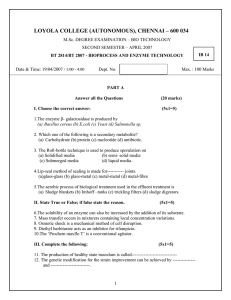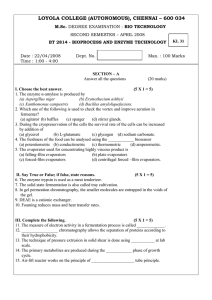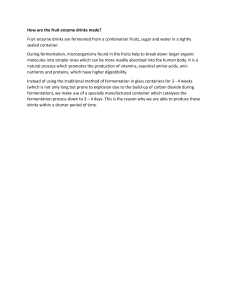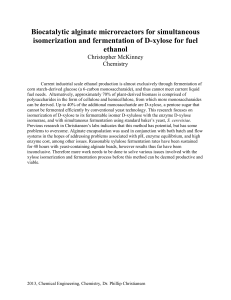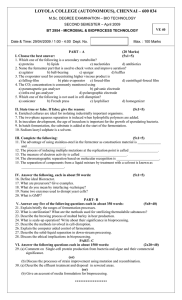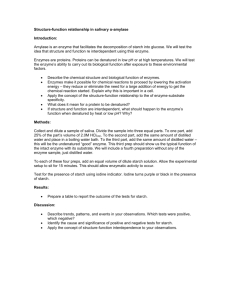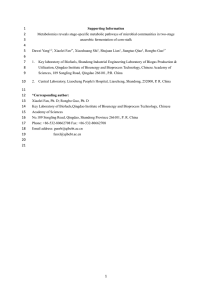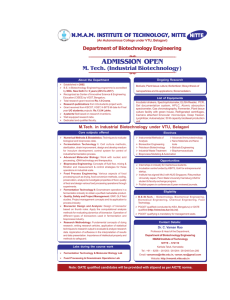BT 2814 - Loyola College
advertisement
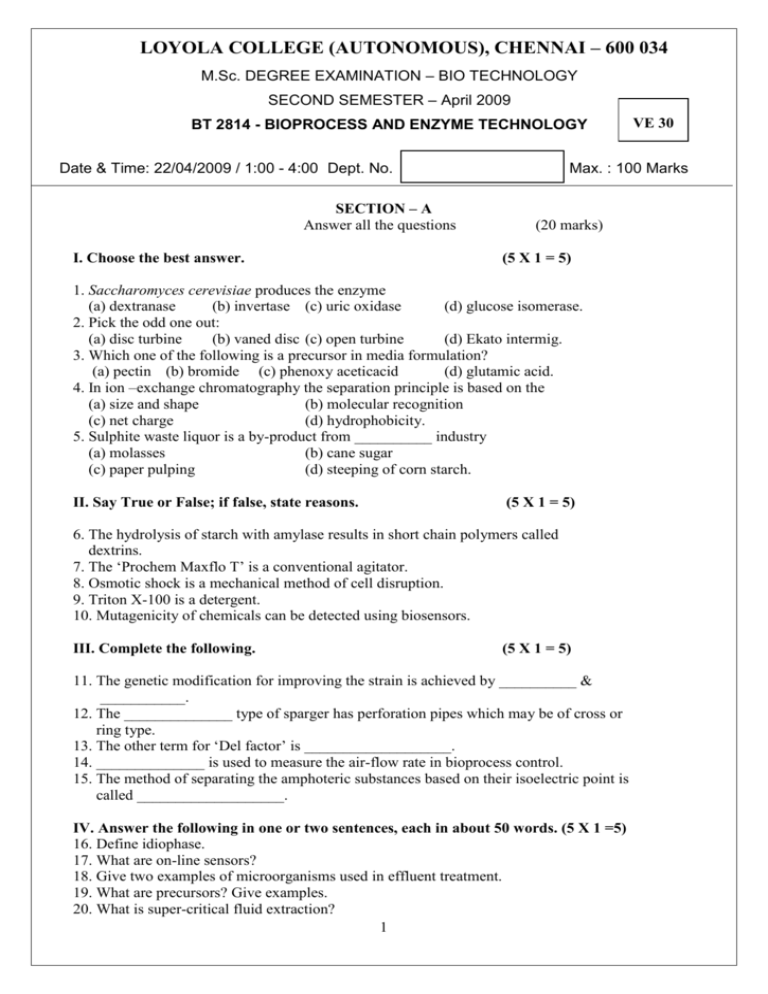
LOYOLA COLLEGE (AUTONOMOUS), CHENNAI – 600 034 M.Sc. DEGREE EXAMINATION – BIO TECHNOLOGY SECOND SEMESTER – April 2009 BT 2814 - BIOPROCESS AND ENZYME TECHNOLOGY Date & Time: 22/04/2009 / 1:00 - 4:00 Dept. No. SECTION – A Answer all the questions I. Choose the best answer. Max. : 100 Marks (20 marks) (5 X 1 = 5) 1. Saccharomyces cerevisiae produces the enzyme (a) dextranase (b) invertase (c) uric oxidase (d) glucose isomerase. 2. Pick the odd one out: (a) disc turbine (b) vaned disc (c) open turbine (d) Ekato intermig. 3. Which one of the following is a precursor in media formulation? (a) pectin (b) bromide (c) phenoxy aceticacid (d) glutamic acid. 4. In ion –exchange chromatography the separation principle is based on the (a) size and shape (b) molecular recognition (c) net charge (d) hydrophobicity. 5. Sulphite waste liquor is a by-product from __________ industry (a) molasses (b) cane sugar (c) paper pulping (d) steeping of corn starch. II. Say True or False; if false, state reasons. (5 X 1 = 5) 6. The hydrolysis of starch with amylase results in short chain polymers called dextrins. 7. The ‘Prochem Maxflo T’ is a conventional agitator. 8. Osmotic shock is a mechanical method of cell disruption. 9. Triton X-100 is a detergent. 10. Mutagenicity of chemicals can be detected using biosensors. III. Complete the following. VE 30 (5 X 1 = 5) 11. The genetic modification for improving the strain is achieved by __________ & ___________. 12. The ______________ type of sparger has perforation pipes which may be of cross or ring type. 13. The other term for ‘Del factor’ is ___________________. 14. ______________ is used to measure the air-flow rate in bioprocess control. 15. The method of separating the amphoteric substances based on their isoelectric point is called ___________________. IV. Answer the following in one or two sentences, each in about 50 words. (5 X 1 =5) 16. Define idiophase. 17. What are on-line sensors? 18. Give two examples of microorganisms used in effluent treatment. 19. What are precursors? Give examples. 20. What is super-critical fluid extraction? 1 SECTION – B V. Answer any five questions, each in about 350 words only. (5 X 8 = 40) 21. Explain the various ranges of fermentation products. 22. Give an account on the industrial applications of enzymes. 23. Illustrate the various methods of preserving the pure cultures. 24. Determine the mass, energy and momentum transfer in transport phenomena. 25. Explain the working mechanism of air-lift reactor with applications. 26. Bring out the significance of computer aided control in fermentation technology. 27. Enumerate and explain the uses of enzymes in biotransformation. 28. Give an account on foaming and its control. SECTION – C VI. Answer the following, each in about 1500 words. (2 x 20 = 40) 29. a) Describe the various types and methods of enzyme immobilization and add a note on its applications. (or) b) Brief out the methods of producing the healthy state of inoculum for bacterial and mycelial processes. 30. a) Explain how media formulation effects the fermentation process. (or) b) Explain the primary separation techniques involved in recovering the metabolites. (cell-disruption techniques and solid-liquid separation). ************** 2
